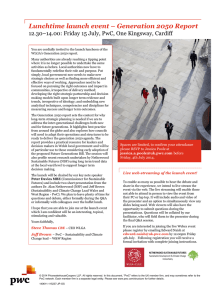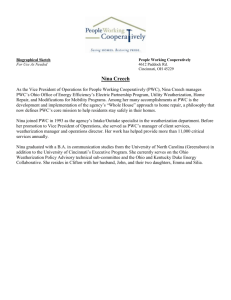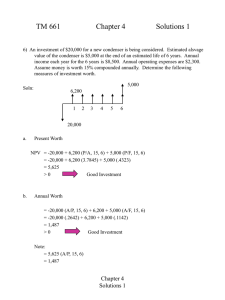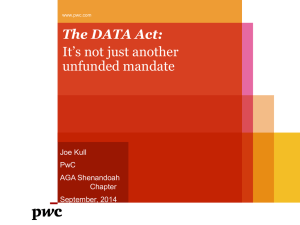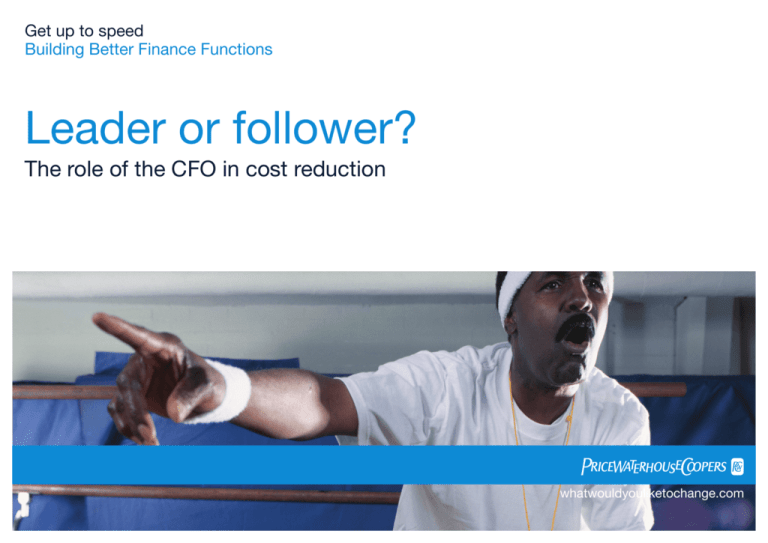
Get up to speed
Building Better Finance Functions
mprovement Consulting
Leader or follower?
The role of the CFO in cost reduction
whatwouldyouliketochange.com
Contents
Introduction
3
1. Earn the mandate 4
2. Develop a plan
5
3. Address the short term as well as the long term
6
4. Tackle complexity and look to service providers
7
5. Communicate – manage your stakeholders
8
Taking out the wrong costs can be worse than taking out no costs at all
9
How PricewaterhouseCoopers can help and key contacts
10
2
PricewaterhouseCoopers LLP
The role of the CFO in cost reduction
Many CFOs are helping their companies
achieve significant and sustainable cost
reductions – are you leading your business
through the downturn?
In a very short time, the CFO’s agenda has inverted
from control at all costs to absolute cost control. The
celebrations following the achievement of statutory
and regulatory compliance, SOx sign off, or Basel
II compliance are a faded memory now that the
pressing issue of business survival is at hand.
Many have described the role of finance as helping
the business to understand the financial implications
of operational decisions. This is certainly true, but
now there is a new perspective: helping business
to understand the operational decisions required to
improve its financial position.
Undoubtedly, CFOs should take a leading role in repositioning the business’s finances. So how can the
CFO, as a functional leader, and indeed the finance
function as a whole, provide the compass from which
companies will navigate to a more profitable future?
Five lines of attack are key:
1. Earn the mandate to lead by demonstrating
competence: Leading from a position of strength
requires having, or building, a reputation for the
finance function as a great service and at low
cost – in the current environment, the focus is on
information.
2. Develop a plan: Assess the value as well as the
cost to the business of all operational and support
activity. Manage the realisation of any programme
returns or benefits achieved.
3. Address the short term fixes decisively:
Review quickly those costs inherent in the
business that can be rapidly addressed without
compromising value.
4. Tackle complexity: Long term sustainable cost
reduction is achieved by eliminating unnecessary
complexity that adds cost but no value.
5. Communicate: Ensure that actions taken are
understood, supported and sustainable through
effective stakeholder management.
Getting up to speed – Building better finance functions
3
1. Earn the mandate
To gain the business’s permission to look at
structural and wider business change, make it
clear that your own house is in order:
• Know yourself. The cost of the finance function
may not be significant when compared to other
organisation costs, but a lean and efficiently run
function is a more compelling platform from which
to launch.
• What do customers want? Information. “Stop,
standardise, simplify” has become a mantra for
many on a cost-reduction mission. How much
of this thinking applies to the finance function?
It’s vital to listen to the voice of your customer, to
focus effort and identify non-essential activities.
The world has changed, at least for the time
being, and many services, seen as ‘must-haves’
before, are now luxuries. As you focus the team,
the priority will become the nature and detail of
information required by the business to manage
through the downturn. What many operational
leaders lack is information on which to base
their decisions. This is where finance plays a
crucial role.
The pre-requisites to getting the mandate from
the business:
• Credibility – get your own house in order first.
Demonstrate to the business that finance has
gone through – or is undergoing – the same cost
reduction pain.
Leading finance functions are highly
efficient, are on top of risk, compliance and
control issues, while providing world-class
business insight for decision support.
Business Insight
• Diplomacy – be aware of the sensitivities, the
‘sacred cows’, and deal with them appropriately.
What can be done to demonstrably prove that
some sacred cows are being sacrificed and
some value enhancing services being preserved?
Are you working behind the scenes to get full
stakeholder commitment?
10
• Advocacy – be visible in driving the management
of cost in the business. Is it clear that this
programme has the backing from the top of the
organisation?
• Decisiveness – act now and draw away from the
competition. If you can cut cost and drive up value
at the same time, then the business will benefit
from the change.
10
Compliance & Control
Efficiency
© 2008 PricewaterhouseCoopers LLP. All rights reserved.
PricewaterhouseCoopers' refers to the network of member firms of PricewaterhouseCoopers
International Limited, each of which is a separate and independent legal entity.
ABC Co
Top Quartile Performance
4
10
Peer Group Above Median
Peer Group Below Median
PricewaterhouseCoopers LLP
2. Develop a plan
“If you don’t know where you’re going,
any road will take you there.”
George Harrison, ‘Any Road’, 2002
• Cost drivers – think through what levers are
available to reduce volumes and complexities.
What is driving the costs and how flexible are
those drivers? To attain the desired income, how
much do the drivers need to change? Which ones
are going to give the biggest impact?
Any cost reduction initiative needs its context,
parameters and desired outcomes to be very clearly
understood. Targeted cuts are far preferable to
across-the-board reductions. Fundamental points to
address are:
• Value drivers – be aware of customer value
and do not destroy value by over-cutting costs.
What qualities will the customer strongly want to
preserve? What controls in the business cannot
afford to be sacrificed?
• Baseline – understand overall business costs,
understand how costs break down. What is fixed
and what is variable? What are the major cost
categories? What contracts are due for renewal?
Where are the opportunities? Which costs
are addressable?
• Prioritise and balance – your key role is to guide
the organisation on the appropriate balance
between cost and value as well as defining a
clearly prioritised programme.
• Outcome definition – be clear about the outcome
of a cost reduction initiative. What is the new level
of annual cost that the business needs to achieve?
What are the timescales to achieve that? What
are the acceptable one-off costs that need to be
incurred to get there? Be sure that you are not
re-arranging the deck chairs on a sinking ship.
• Track benefits – ensure you realise the benefits of
the cost reductions. As the costs are managed out,
what measurement system is in place to assess
impact against expected impact? Many companies
have found it difficult to get credit in their share
price if the benefits of cost reduction programmes
can’t be directly proved to the market. Are
individuals assessed on the level of achievement
of the cost reduction targets?
Impact and benefit timing of cost reduction
initiatives (illustrative)
Cost impact
Enterprise-wide
cost reduction
programmes
Cost reviews of
overhead areas
Discretionary
short term
spend
Short term
Tactical
Legal entity
simplification
Major contract
reviews
Long term
Strategic
• Engage your team – ensure your finance team
are aware and engaged in cost reduction initiatives
and are supporting you in driving these changes
across the organisation.
Getting up to speed – Building better finance functions
5
3. Address the short term as well as the long term
Fixed, semi-fixed and variable costs are theoretically
simple but practically difficult. The priority in the short
term is for the finance team to help management
understand the P&L from two perspectives: the cost
structure and cost drivers, the value chain and value
drivers – and the quantum of each. As an illustration,
travel expense is a variable cost in most businesses
and an early target for cost containment. However,
the value to the business will vary considerably
depending on who is incurring those expenses.
A sales force that cannot travel is of little use to the
company; but fewer internal face-to-face meetings
may actually improve productivity.
Discretionary short-term spending and quick wins
should be balanced with any potential negative
impact on morale/culture. Cost reduction gains
need to be sustainable, which demands culture
change: a cost control mentality alongside costcontrol mechanisms. Yet acting fast and getting the
quick wins can make a big difference to long-term
prospects, improving the outlook until longer term
initiatives start to deliver. Low-hanging fruit should be
identified – and taken.
Strategic Cost Management in Oil and Gas
A multi-billion dollar oil and gas business was facing
continuing downward pressure on margins and
free cash generation was declining. The company
needed to change into a sustainably
cash-generative business.
Over a two year period, using the approach shown
in figure 1, PricewaterhouseCoopers (PwC) helped
the client achieve both quick wins and a move to
sustainable cost reductions through a fundamental
shift from alignment around assets to delivery
functions. The project team tackled efficiency,
planning and execution; it analysed governance,
helping to define and implement simplified,
standardised processes.
In Year 1, more than 300 people were engaged
in building the case for change and in redesign.
Immediate cash benefits and ongoing opportunities
were identified, e.g. through audits of main contracts
in all sectors. Cash costs were restored from a large
forecasted overspend to being delivered significantly
under forecast.
From Year 2 and onward, savings will continue, due
to factors including: a 90% reduction in process
complexity; a removal of one layer of management
and reduction in head count; a step change in
capability around cost and contract management;
and continuous improvement plans embedded to
simplify processes further.
Figure 1 – example project approach to strategic cost management
R ight Plan
R ight S hape
R ight S ize
Design
Organisation
Headcount R eduction The way We Work
Programme Team
Leadership Team
Entire Business Involved
Supply Chain
Standardisation
/ Simplification
Benefit
Diagnostic
Mobilisation
Workshops
R ight Work
Restructuring
Restructuring
Standardisation / Simplification
/ Cost Accountability
Contract Reviews & Waste Elimination
Q2
Year 1
6
Cost Pilot / Budget Reviews
Q3
Q4
Q1
Year 2
Q2
Q3
Q4
PricewaterhouseCoopers LLP
4. Tackle complexity and look to service providers
It may not feel like it, but there is today a
window of opportunity that will close as the
green shoots of recovery start to appear.
In many businesses, there has been a debate
regarding complexity across products, services,
target market, sales channels, legal structure,
management structures and governance. These
debates are always difficult and sensitive. The current
business imperatives for change and cost reduction
can provide the opportunity to address entrenched
structures, behaviours or views – changes which will
be of great benefit for the future. At this time people
are most likely to accept that there can be no
“sacred cows” in operations or structures.
Take a radical look at structures
By encouraging the tackling of structural complexity,
the CFO can drive direct benefits including reduced
internal administration costs; reduced external and
internal audit costs; improved transparency; and
aligning management structure with legal structure,
reducing fiscal compliance risk. Additional indirect
benefits are also there for the taking: potential tax
benefits; GAAP reduction (e.g. conversion to IFRS);
reduced internal support e.g. Directors; and access to
trapped cash & optimising capital adequacy structure
to rationalise funding & treasury structures.
Structural change review provides an opportunity to
examine the portfolio of legal structures, with the aim
of reducing the complexity of the corporate structure,
unlocking benefits for the organisation as a whole.
• Eliminate all dormant legal entities and minimise
operating entities; consider single entity (SE)
structure for European operations.
• Consider restructuring regional and global
businesses to a ‘Principal’ and ‘Branch’ structure.
• Evaluate the tax optimisation benefits of locating
‘Principal’ entities into low-cost tax jurisdictions.
If that’s not viable, evaluate tax optimisation of
existing structures.
Getting up to speed – Building better finance functions
Rethink service delivery: shared services
and outsourcing
When looking at the operation of support services
(finance, HR, IT, procurement) many companies
have opted to move these activities into a shared
services organisation. Others have outsourced. Many
have done both. In many cases these moves go
hand in hand – and go alongside IT rationalisation.
Consolidation and simplification of operating
processes and reduction of overheads can have
a twofold benefit: boosting the balance sheet and
reducing operating costs. For the CFO looking for
a swift method to hit both of these goals, then both
shared services and outsourcing warrant
close inspection.
-
Shared service organisation
(e.g. transaction processing,
reporting capability off-shore)
SSO
Business/
operating
units
BPO
Local service delivery
(e.g. decision support, service desk
Business process outsourcer
(e.g. credit control, banking services)
7
5. Communicate – manage your stakeholders
At times of change, it is important to optimise
relationships with all key stakeholder groups.
Successful management of communications
with these groups is absolutely critical to
success. Your goal is to retain business
confidence and avoid surprises. Stakeholders
need to be engaged in a positive dialogue
about how the situation is being handled, the
opportunities it presents, what is being done
to address any underlying weaknesses in the
business structure and the strengths that set
the business apart from its competitors.
Successful businesses proactively structure activities
and communications in a targeted way for each
stakeholder group:
• Customers – Reward loyalty, ensuring any
retention efforts are targeted and cost effective.
Increase your focus on customer credit to reduce
bad debts; ensure plans are in place to proactively
capture customers from failed competitors;
consider sales aid and customer financing
opportunities.
• Investors – Proactively appraise the investor /
analyst community about your financial projections
/ outturns. Regular scenario planning / modelling
becomes critical as a source of strategic
information; be prepared and ready to tap investor
markets, as “windows of opportunity” open up.
• Suppliers – Categorise suppliers into critical
/ desirable groups and focus priority spend
on priority categories. Review contract and
procurement policies; optimise purchasing
power with suppliers, aiming to prioritise spend
and consolidate / reduce the supplier base.
Communicate regularly with critical suppliers: they
will want to help you reach your business goals to
keep their key supplier role.
8
• Management & Staff – Focus attention on
retention of highest value employees – those
that must be retained as the growth engine of
the business. Look at pay structures / flexible
working time and benchmark remuneration against
competitors; look at outsourcing opportunities;
consider works council / union implications of any
changes.
Closing the gap
Good stakeholder management during difficult times
is crucial to businesses executing a winning strategy.
In today’s often complicated business environment,
the only way to manage these diverse relationships
effectively is through good communication.
Shareholders and lenders need to be kept informed
and don’t like information to be kept from them or
nasty surprises. Under these circumstances, it is
almost impossible to over-communicate – and far
preferable to overdo it rather than leave
messages unsaid.
PricewaterhouseCoopers LLP
Taking out the wrong costs can be worse than taking out
no costs at all
The skill and value of the finance function when
considering cost containment or cost reduction
activities cannot be over-emphasised. The CFO as an
individual, and the function as a whole, have a unique
view of the business across its costs, complexity and
revenue drivers.
This information is fundamental to creating the focus
to change the organisation into one that survives
and prospers. No one would advocate the execution
of a plan based on flawed or incomplete analysis.
The finance function, so often the ‘controllers’ of the
business may yet become its saviours.
Getting up to speed – Building better finance functions
How PwC can help
PricewaterhouseCoopers works to solve complex
business issues – locally and globally. Our teams
draw upon skills in finance, risk, regulation, people,
operations and technology to capture opportunities,
navigate risk and deliver lasting change across
business networks.
We take time to listen to your situation and offer a
range of smart choices to consider – choices based
on independent and challenging insights, supported
by facts and industry benchmarks.
9
Contacts
Global/Europe
Central & Eastern Europe
South America
Martin Petry
+49 201 438 2116
martin.petry@de.pwc.com
Marc Goessi
+41 58 792 44 00
marc.goessi@ch.pwc.com
Luiz Viotti
+55 11 3674 3413
luiz.viotti@br.pwc.com
Asia
China/Hong Kong/Singapore
United Kingdom
Key-Hak Lee
+82 (2) 709 7965
key-hak.lee@kr.pwc.com
Edmund Lee
+852 2289 2714
edmund.ym.lee@hk.pwc.com
Nick Jarman
+44 (0) 20 7804 4865
nick.jarman@uk.pwc.com
Australia
India
United States
Sarah Laidlaw Meehan
+61 3 8603 2327
sarah.laidlaw.meehan@au.pwc.com
Mohan Verma
+ 91 22 6669 1301
mohan.verma@in.pwc.com
Mike Boyle
+1 617 530 5933
mike.boyle@us.pwc.com
Canada
Southern Africa
Philip Townsend
+1 416 941 8220
philip.e.townsend@ca.pwc.com
Jan Gey van Pittius
+27 (11) 797 5331
jan.gey.van.pittius@za.pwc.com
Tracey Riley
+1 416 941 8422
tracey.riley@ca.pwc.com
10
PricewaterhouseCoopers LLP
Getting up to speed – Building better finance functions
11
pwc.com/finance
This publication has been prepared for general guidance on matters of interest only, and does not constitute professional advice. You should not act upon the information contained in this publication without obtaining specific professional advice. No representation or warranty (express or
implied) is given as to the accuracy or completeness of the information contained in this publication, and, to the extent permitted by law, PricewaterhouseCoopers LLP, its members, employees and agents do not accept or assume any liability, responsibility or duty of care for any consequences
of you or anyone else acting, or refraining to act, in reliance on the information contained in this publication or for any decision based on it.
© 2009 PricewaterhouseCoopers LLP. All rights reserved. “PricewaterhouseCoopers” refers to PricewaterhouseCoopers LLP (a limited liability partnership in the United Kingdom) or, as the context requires, the PricewaterhouseCoopers global network or other member firms of the network, each
of which is a separate and independent legal entity. Design: 0900409_pic_aa




